#flextronics
Explore tagged Tumblr posts
Text
Neoliberalismo, maquiladora —injusticia en su máxima expresión— y narcisismo patológico
Así, en el sistema neoliberal, las corporaciones (a las que Noam Chomsky llama tiranías privadas) han elevado sus utilidades en proporción exponencial mientras un porcentaje muy alto de las poblaciones de las naciones que viven bajo ese sistema económico han visto derrumbarse sus niveles de vida y cientos, tal vez miles de millones de habitantes en las democracias neoliberales, enfrentan una realidad terrible. Han perdido sus derechos laborales, trabajan turnos de 12 horas o más que provocan un agotamiento que destruye la salud tanto física como mental y conduce a una tumba prematura.
Volviendo al tema que me ocupa, la maquiladora electrónica —donde me esforcé y demostré que podía ser un empleado muy competente, que habría realizado una contribución valiosa para la empresa que me contratara, todo lo cual resultó inútil, no me llevó a nada y caí en una desesperación que bien pudo haberme costado la vida o al menos pudo haberme arruinado— no es otra cosa que un caldo de cultivo para esa patología tan destructiva en el ser humano, el narcisismo.
David megalómano en AVEX Electronics, entre noviembre de 1997 y enero de 1998, me atacó con saña siendo mi jefe directo (una violencia de magnitud homicida), lo cual mandó mi existencia hacia un precipicio. Seis años más tarde, intenté incorporarme a otra empresa maquiladora de ese ramo, electrónico, ahora en Solectron, y me topé con otro mal individuo que padece un trastorno narcisista grave, Álvaro García.

El día que renuncié a esa segunda maquiladora, hablé con una dama que ocupaba un puesto administrativo poco importante en esa nave donde se me asignó ese trabajo de traducción con remuneración de operador básico (obrero) y ella me expresó la idea que concibe cualquier persona que cuenta con la capacidad de percibir la realidad: se maneja al empleado como a un objeto, una cosa; burocratismo deshumanizado.
Ese es el mundo en que vivimos y las patologías narcisistas —parte de lo más destructivo del ser humano, con la necrofilia (amor a la muerte) y los vínculos incestuosos— crecen sin medida porque son fomentadas por quienes acaparan el capital, siempre vinculados con el poder político, que se oponen con toda su energía a que se combata la injusticia social y la desigualdad porque a ellos les favorece.
Ahora que he leído y estudiado a grandes humanistas como Erich Fromm y Noam Chomsky, ha aumentado mi capacidad para sentir empatía. Me doy cuenta de que la maquiladora, un lugar donde se busca elevar al máximo la injusticia, no era para mí. Pese a lo mucho que he sufrido por la injusticia y la violencia de que fui objeto, puedo asimilar ese dolor, convertirlo en aprendizaje y utilizar la experiencia para realizar mis potencialidades. La filosofía dice que el único interés legítimo del hombre (usando la palabra hombre como sinónimo de ser humano) es la búsqueda de la virtud. Sentirse un semidiós (manifestación de narcisismo), superior al resto de los mortales, no es otra cosa que miseria humana.
Mi postura en la vida puede expresarse con dos principios:
La justicia por encima de todas las cosas, y
Una sola raza, la raza humana.
Seguiré con mi vida, de alguna manera.
Agradezco a quien me haga el favor de leer lo que escribo.
1 note
·
View note
Text
#Flextron#BatteryAsAService#ElectricMobility#RapidCharging#Sustainability#EVInfrastructure#electricvehiclesnews#evtimes#autoevtimes#evbusines
0 notes
Text
EMS and ODM, Global Market Size Forecast, Top 8 Players Rank and Market Share
EMS and ODM Market Summary
Electronics manufacturing services (EMS) is a term used for companies that test, manufacture, distribute, and provide return/repair services for electronic components and assemblies for original equipment manufacturers (OEMs).
The concept is also referred to as electronics contract manufacturing (ECM).
An original design manufacturer (ODM) is a company that designs and manufactures a product as specified and eventually rebranded by another firm for sale. Such companies allow the firm that owns or licenses the Company to produce products (either as a supplement or solely) without having to engage in the organization or running of a factory.
According to the new market research report “Global EMS and ODM Market Report 2023-2029”, published by QYResearch, the global EMS and ODM market size is projected to reach USD 855210 million by 2029, at a CAGR of 4.1% during the forecast period.
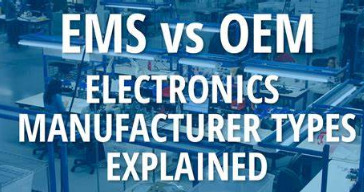
Figure. Global EMS and ODM Market Size (US$ Million), 2018-2029
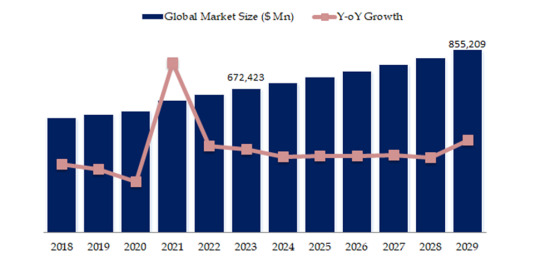
Based on or includes research from QYResearch: Global EMS and ODM Market Report 2023-2029.
Market Trends:
In a short period of time, markets and consumers’ behaviours have undergone drastic changes due to the outbreak of the coronavirus (COVID-19). From people raiding grocery store aisles to the cancelation of the world’s most significant events and mandates for “non-essential” businesses to temporarily close, this pandemic is having a substantial impact on the economy and society as we knew it.
1. Despite all of the negatives that have come from the COVID-19 pandemic, it has led to several positive outcomes. For example if your product or service can be marketed to coronavirus patients, it is most likely doing well. With the development of the epidemic, there will still be considerable development in the medical industry in 2021.
2. Most of the traditional EMS centres in Southeast Asia will see above trend growth from 2021 – 2025 in response to both trade tensions, and real and perceived excess concentration of manufacturing in China by some leading western OEMs.
3. Over the next 5 years, a number of low-cost Asian countries will see new investments in their nascent tech manufacturing industries. This likely includes Laos, Cambodia, Myanmar, and Bangladesh. Much of this investment will be based on the size of existing labor force, as well as growth rates of the labor force and the burgeoning local consumer markets. EMS and ODM companies from Foxconn to Flex realize that these large investments in new manufacturing centers often take 15 years or more before they really become a competitive force at meaningful scale.
4. A new breed of mid-sized, China based/China only EMS providers will find their wings and expand outside of China to compete with larger multi-national EMS providers from Taiwan and the US.
Market Drivers:
The key driver for the electronics contract manufacturing industry (EMS and ODM) is costs.
High-volume manufacturing in the form of EMS / ODM can be attracted to countries by offering low-cost labor and availability of components
The critical success factors for an EMS / ODM model able to offer real outsourcing cost reductions and benefits that actually help OEMs reduce costs and save money, include:
Low cost geographic destinations
Component costs
Intellectual property (IP) protection
Government tax incentives
Figure. EMS and ODM, Global Market Size, Ranking of Major Manufacturers 2022

Based on or includes research from QYResearch: Global EMS and ODM Market Report 2023-2029.
The global key manufacturers of EMS and ODM include HONHAI, Compal, Pegatron, Quanta, Jabil, Flextronics, Luxshare, Wistron, Inventec, BYD Electronics, etc. In 2022, the share of top 5 players exceeds 52.68%.
Figure. EMS and ODM, Global Market Size, Split by Product Segment
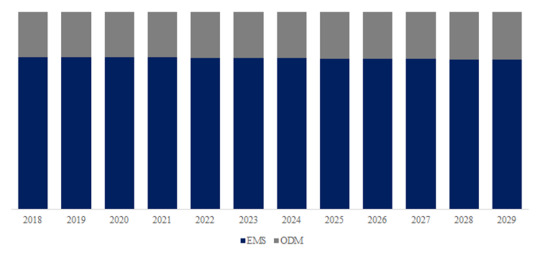
Based on or includes research from QYResearch: Global EMS and ODM Market Report 2023-2029.
In 2022, EMS accounted US$ 493771 million in the global EMS and ODM market. And this type segment is poised to reach US$ 646661 million by 2029.
Figure. EMS and ODM, Global Market Size, Split by Application Segment
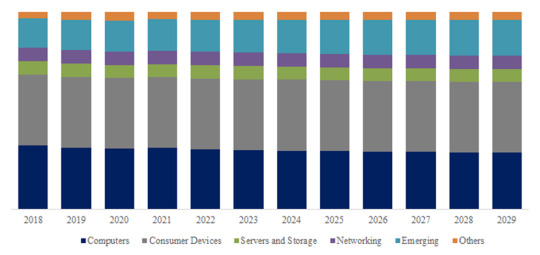
Based on or includes research from QYResearch: Global EMS and ODM Market Report 2023-2029.
In 2022, Consumer Devices accounted US$ 231053 million in the global EMS and ODM market, share the largest. And this type segment is poised to reach US$ 306990 million by 2029.
Figure. EMS and ODM, Global Market Size, Split by Region
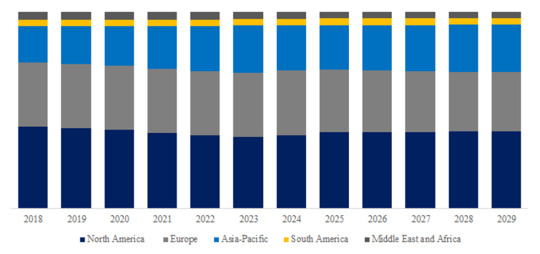
Based on or includes research from QYResearch: Global EMS and ODM Market Report 2023-2029.
In EMS and ODM market, North America occupies an important share, with a market share of 36% in 2022, and the market size is expected to reach US$ 191775 million by 2029.
About The Authors
ShiYuanyuan - Lead Author
Email: [email protected]
Shi Yuanyuan is a senior technology and market analyst, specializing in chemical industry, agriculture, consumer goods, etc. Analyst Shi Yuanyuan has 3 years of experience in the chemical industry and consumer goods industry, focusing on APIs, chemical intermediates, household appliances, wearable devices, 3C products, etc. She can provide the development of technical and market reports and also participate in custom projects.
About QYResearch
QYResearch founded in California, USA in 2007.It is a leading global market research and consulting company. With over 16 years’ experience and professional research team in various cities over the world QY Research focuses on management consulting, database and seminar services, IPO consulting, industry chain research and customized research to help our clients in providing non-linear revenue model and make them successful. We are globally recognized for our expansive portfolio of services, good corporate citizenship, and our strong commitment to sustainability. Up to now, we have cooperated with more than 60,000 clients across five continents. Let’s work closely with you and build a bold and better future.
QYResearch is a world-renowned large-scale consulting company. The industry covers various high-tech industry chain market segments, spanning the semiconductor industry chain (semiconductor equipment and parts, semiconductor materials, ICs, Foundry, packaging and testing, discrete devices, sensors, optoelectronic devices), photovoltaic industry chain (equipment, cells, modules, auxiliary material brackets, inverters, power station terminals), new energy automobile industry chain (batteries and materials, auto parts, batteries, motors, electronic control, automotive semiconductors, etc.), communication industry chain (communication system equipment, terminal equipment, electronic components, RF front-end, optical modules, 4G/5G/6G, broadband, IoT, digital economy, AI), advanced materials industry Chain (metal materials, polymer materials, ceramic materials, nano materials, etc.), machinery manufacturing industry chain (CNC machine tools, construction machinery, electrical machinery, 3C automation, industrial robots, lasers, industrial control, drones), food, beverages and pharmaceuticals, medical equipment, agriculture, etc.
3 notes
·
View notes
Text
MIT announces the Initiative for New Manufacturing
New Post has been published on https://sunalei.org/news/mit-announces-the-initiative-for-new-manufacturing/
MIT announces the Initiative for New Manufacturing
MIT today launched its Initiative for New Manufacturing (INM), an Institute-wide effort to reinfuse U.S. industrial production with leading-edge technologies, bolster crucial U.S. economic sectors, and ignite job creation.
The initiative will encompass advanced research, innovative education programs, and partnership with companies across many sectors, in a bid to help transform manufacturing and elevate its impact.
“We want to work with firms big and small, in cities, small towns and everywhere in between, to help them adopt new approaches for increased productivity,” MIT President Sally A. Kornbluth wrote in a letter to the Institute community this morning. “We want to deliberately design high-quality, human-centered manufacturing jobs that bring new life to communities across the country.”
Play video
Kornbluth added: “Helping America build a future of new manufacturing is a perfect job for MIT — and I’m convinced that there is no more important work we can do to meet the moment and serve the nation now.”
The Initiative for New Manufacturing also announced its first six founding industry consortium members: Amgen, Flextronics International USA, GE Vernova, PTC, Sanofi, and Siemens. Participants in the INM Industry Consortium will support seed projects proposed by MIT researchers, initially in the area of artificial intelligence for manufacturing.
INM joins the ranks of MIT’s other presidential initiatives — including The Climate Project at MIT; MITHIC, which supports the human-centered disciplines; MIT HEALS, centered on the life sciences and health; and MGAIC, the MIT Generative AI Impact Consortium.
“There is tremendous opportunity to bring together a vibrant community working across every scale — from nanotechnology to large-scale manufacturing — and across a wide-range of applications including semiconductors, medical devices, automotive, energy systems, and biotechnology,” says Anantha Chandrakasan, MIT’s chief innovation and strategy officer and dean of engineering, who is part of the initiative’s leadership team. “MIT is uniquely positioned to harness the transformative power of digital tools and AI to shape future of manufacturing. I’m truly excited about what we can build together and the synergies this creates with other cross-cutting initiatives across the Institute.”
The initiative is just the latest MIT-centered effort in recent decades aiming to expand American manufacturing. A faculty research group wrote the 1989 bestseller “Made in America: Regaining the Productive Edge,” advocating for a renewal of manufacturing; another MIT project, called Production in the Innovation Economy, called for expanded manufacturing in the early 2010s. In 2016, MIT also founded The Engine, a venture fund investing in hardware-based “tough tech” start-ups including many with potential to became substantial manufacturing firms.
As developed, the MIT Initiative for New Manufacturing is based around four major themes:
Reimagining manufacturing technologies and systems: realizing breakthrough technologies and system-level approaches to advance energy production, health care, computing, transportation, consumer products, and more;
Elevating the productivity and experience of manufacturing: developing and deploying new digitally driven methods and tools to amplify productivity and improve the human experience of manufacturing;
Scaling new manufacturing: accelerating the scaling of manufacturing companies and transforming supply chains to maximize efficiency and resilience, fostering product innovation and business growth; and
Transforming the manufacturing base: driving the deployment of a sustainable global manufacturing ecosystem that provides compelling opportunities to workers, with major efforts focused on the U.S.
The initiative has mapped out many concrete activities and programs, which will include an Institute-wide research program on emerging technologies and other major topics; workforce and education programs; and industry engagement and participation. INM also aims to establish new labs for developing manufacturing tools and techniques; a “factory observatory” program which immerses students in manufacturing through visits to production sites; and key “pillars” focusing on areas from semiconductors and biomanufacturing to defense and aviation.
The workforce and education element of INM will include TechAMP, an MIT-created program that works with community colleges to bridge the gap between technicians and engineers; AI-driven teaching tools; professional education; and an effort to expand manufacturing education on campus in collaboration with MIT departments and degree programs.
INM’s leadership team has three faculty co-directors: John Hart, the Class of 1922 Professor and head of the Department of Mechanical Engineering; Suzanne Berger, Institute Professor at MIT and a political scientist who has conducted influential empirical studies of manufacturing; and Chris Love, the Raymond A. and Helen E. St. Laurent Professor of Chemical Engineering. The initiative’s executive director is Julie Diop.
The initiative is in the process of forming a faculty steering committee with representation from across the Institute, as well as an external advisory board. INM stems partly from the work of the Manufacturing@MIT working group, formed in 2022 to assess many of these issues.
The launch of the new initiative was previewed at a daylong MIT symposium on May 7, titled “A Vision for New Manufacturing.” The event, held before a capacity audience in MIT’s Wong Auditorium, featured over 30 speakers from a wide range of manufacturing sectors.
“The rationale for growing and transforming U.S. manufacturing has never been more urgent than it is today,” Berger said at the event. “What we are trying to build at MIT now is not just another research project. … Together, with people in this room and outside this room, we’re trying to change what’s happening in our country.”
“We need to think about the importance of manufacturing again, because it is what brings product ideas to people,” Love told MIT News. “For instance, in biotechnology, new life-saving medicines can’t reach patients without manufacturing. There is a real urgency about this issue for both economic prosperity and creating jobs. We have seen the impact for our country when we have lost our lead in manufacturing in some sectors. Biotechnology, where the U.S. has been the global leader for more than 40 years, offers the potential to promote new robust economies here, but we need to advance our capabilities in biomanufacturing to maintain our advantage in this area.”
Hart adds: “While manufacturing feels very timely today, it is of enduring importance. Manufactured products enable our daily lives and manufacturing is critical to advancing the frontiers of technology and society.��Our efforts leading up to launch of the initiative revealed great excitement about manufacturing across MIT, especially from students. Working with industry — from small to large companies, and from young startups to industrial giants — will be instrumental to creating impact and realizing the vision for new manufacturing.”
In her letter to the MIT community today, Kornbluth stressed that the initiative’s goal is to drive transformation by making manufacturing more productive, resilient, and sustainable.
“We want to reimagine manufacturing technologies and systems to advance fields like energy production, health care, computing, transportation, consumer products, and more,” she wrote. “And we want to reach well beyond the shop floor to tackle challenges like how to make supply chains more resilient, and how to inform public policy to foster a broad, healthy manufacturing ecosystem that can drive decades of innovation and growth.”
0 notes
Text
Apple iPhones will be directed to a 25% tariff if it is made outside us
Tim Cook, General Director of Apple, on the left, and President Donald Trump talk to the press during a trip to Flextronics Computer Manufacturing Facility in Austin, Texas, where it consists of MAC of Apple, November 20, 2019. Mandel I | AFP Getty images President Donald Trump said in Social media After Friday Apple he will have to pay tariff 25% or more for iPhones Made outside the United…
0 notes
Text
Apple iPhones will be directed to a 25% tariff if it is made outside us
Tim Cook, General Director of Apple, on the left, and President Donald Trump talk to the press during a trip to Flextronics Computer Manufacturing Facility in Austin, Texas, where it consists of MAC of Apple, November 20, 2019. Mandel I | AFP Getty images President Donald Trump said in Social media After Friday Apple he will have to pay tariff 25% or more for iPhones Made outside the United…
0 notes
Text
Frena Semarnat Centro de Convenciones en El Chamizal porque ‘Los Hoyos son inundables’
Dictamen del gobierno federal establece que no puede construirse ningún tipo de desarrollo o infraestructura en Los Hoyos de El Chamizal como pretenden empresarios; celebran opositores a la construcción del Centro de Convenciones en esa área zona, pero advierten que la defensa del parque va a continuar
Los Hoyos de El Chamizal son áreas “sujetas a inundaciones recurrentes” por el desbordamiento del río Bravo, determinó la Secretaría del Medio Ambiente y Recursos Naturales (Semarnat), por lo que no se puede construir ningún tipo de desarrollo o infraestructura en esa zona donde empresarios impulsaban un proyecto para construir un Centro de Convenciones y Exposiciones.
“Se concluye que los predios conocidos como Los Hoyos constituyen llanuras de inundación, es decir, son superficies adyacentes al río sujetas a inundaciones recurrentes y que, por su naturaleza, deben ser preservadas en sus condiciones naturales para evitar daños por el desbordamiento del río. Por lo tanto, se deben respetar y conservar las condiciones naturales de la zona, a efecto de mantener la salud y seguridad ambiental y humana, y no permitir ningún desarrollo de infraestructura que las afecte”, concluye el estudio dado a conocer por la Semarnat este jueves.
Con esta resolución la construcción del Centro de Convenciones en el lugar practicamente se detiene, por lo que los opositores al proyecto en esa zona consideran la determinación de la autoridad federal les da la razón.
El vocero del Frente por la Defensa del Chamizal, Daniel Delgadillo opinó que se trata de un gran logro para toda la comunidad juarense y para el patrimonio ecológico de la ciudad y del país.
“Fue un movimiento ciudadano, se decía que era una lucha de David contra Goliat, y se logró ganar a ese gran poder empresarial”, comentó Delgadillo.
También enfatizó que se trata de un triunfo en una primera gran batalla pero que el trabajo por la defensa del Chamizal continúa.
Refirió que como segundo paso se busca detener y revertir el daño que se ocasiona en el parque Niños Héroes en donde la empresa maquiladora Flextronics construye la ampliación de su estacionamiento.
“Ahora, como categóricamente dijimos que no se podía construir el Centro de Convenciones decimos que en el parque Niños Héroes se va a tener que detener esa obra o revertir el daño, eso es lo que sigue”, señaló Delgadillo.
De la misma manera mencionó que al igual que el comodato para el Centro de Convenciones tienen que desaparecer todos los comodatos del Chamizal.
Mencionó que finalmente la lucha es para que El Chamizal se establezca como Parque Nacional ya que el Municipio ha sido incapaz de cuidarlo y administrarlo.
La Semarnat indicó en su comunicado que el estudio y opinión técnica sobre la Cuenca del Río Bravo en la zona de El Chamizal se realizó a través del Instituto Mexicano de Tecnología del Agua (IMTA). Esto, “en cumplimiento a la instrucción del presidente Andrés Manuel López Obrador, y en seguimiento a los acuerdos establecidos dentro del proceso de diálogo y colaboración entre los tres órdenes de gobierno y representantes de diversos colectivos de la comunidad de Juárez”.
En abril de 2021, el Municipio de Juárez entregó 71 mil 848 metros cuadrados de El Chamizal por tiempo indefinido a Exposiciones y Convenciones de Juárez A.C., para la construcción del centro en esa zona.
A principios de febrero de 2022, la Semarnat y el Gobierno municipal determinaron suspender la obra hasta que se realice una delimitación de predios federales y municipales en la zona de El Chamizal.
En marzo del 2022, 101 empresarios – entre ellos Alejandra de La Vega, Carlos Murguía Chávez, Miguel Fernández Iturriza, Miguel Zaragoza Fuentes, Octavio Muñoz y Pablo Cuarón– lanzaron un posicionamiento público donde respaldan la construcción del Centro de Exposiciones y Convenciones en los terrenos del Corredor Bertha Chiu, en la zona del Chamizal.
Este jueves la Semarnat dio a conocer que en esa zona conocida como Los Hoyos constituyen llanuras de inundación, por lo tanto no se debe permitir ningún desarrollo de infraestructura que las afecte.
El grupo de empresarios promotor del Centro de Convenciones no ha expuesto su postura ante la determinación dada a conocer este jueves por la dependencia del gobierno federal
0 notes
Text
1 note
·
View note
Text

BRP Infotech and Flextronics have united in a green partnership aimed at driving eco-friendly e-waste recycling solutions. Together, we can make a significant difference in promoting sustainable practices and protecting our environment. Let’s collaborate to implement innovative recycling initiatives that benefit both our communities and the planet. Your expertise and commitment are crucial in making this endeavor successful.
0 notes
Text

Un día como hoy (1 de diciembre) en la tecnología
El 1 de diciembre de 1999 se funda la compañía de wearebles (bracaletes UP y UP24, dispositivos de audio portátiles, auriculares y dispositivos de cancelación de ruido) Jawbone. Se disolvió en julio de 2017 que comenzó por una demanda de Flextronics por incumplimiento de contrato #retrocomputingmx #jawbone #wearables
0 notes
Text

Send from Sansgreet Android App. Sanskrit greetings app from team @livesanskrit .
It's the first Android app for sending @sanskrit greetings. Download app from https://livesanskrit.com/sansgreet
Revathi Advaithi.
Revathi Advaithi is an Indian-born American business executive. She is the CEO of Flex (formerly Flextronics) and is an advocate for women in STEM and in the workplace. Prior to joining Flex in 2019, Advaithi worked in various leadership positions at Eaton and Honeywell. Mike McNamara
Advaithi is a co-chair of the World Economic Forum (WEF) Advanced Manufacturing CEO Community (2022) and joined the WEF Alliance of CEO Climate Leaders (2021). She currently serves as an independent director for the Board of Directors of Uber and Catalyst.org. She is also a member of the MIT Presidential CEO Advisory Board. She was named to Fortune’s Most Powerful Women list in 2019, 2020, and 2021.
#sansgreet #sanskritgreetings #greetingsinsanskrit #sanskritquotes #sanskritthoughts #emergingsanskrit #sanskrittrends #trendsinsanskrit #livesanskrit #sanskritlanguage #sanskritlove #sanskritdailyquotes #sanskritdailythoughts #sanskrit #resanskrit #celebratingsanskrit #revathiadvaithi #revathi #advaithi #businesswoman #businessexecutive #flex #flextronics #stem #birlainstituteoftechnologyandsciences #thunderbirdschoolofglobalmanagement #worldeconomicforum #uber #powerfulwomen #womenhood
#greetingsinsanskrit#sanskritgreetings#sanskrittrends#trendsinsanskrit#livesanskrit#sanskrit#celebratingsanskrit#incredibleindia#uber taxi
0 notes
Text
Intentar regresar a la maquiladora electrónica, Solectron

Para diciembre de 2003 (habían pasado cerca de seis años), habiendo vivido en la desesperación porque además mis padres y otros miembros de mi familia (hermanas y cónyuges) me habían violentado de una manera terrible, había vivido con hambre sin merecer eso, etc., se me ocurrió intentar ingresar en una empresa maquiladora del ramo electrónico. La única posibilidad era como operador (eufemismo de la palabra obrero), porque pese a mis estudios de ingeniería y mi dominio de una lengua extranjera, no lograría que nadie me tomara en cuenta por el modo como se maneja la contratación, el reclutamiento, de una manera total y absolutamente burocratizada.
Mi plan era ingresar mencionando bachillerato (preparatoria) como escolaridad, para una vez dentro de la empresa, informar a Recursos Humanos que contaba con estudios de ingeniería y dominaba una lengua extranjera, podía hablar, leer, escribir y traducir del inglés a mi lengua materna, el español.
Esto último (dominar una lengua extranjera) podría parecer algo de menor importancia, pero no es así. Algo importantísimo para determinar el nivel intelectual de un individuo es el vocabulario que maneja, el número de palabras que conoce. Una realidad vergonzosa de mi país es que contamos con uno de los peores sistemas educativos de todo el mundo. El vocabulario del habitante promedio anda en unas 300 palabras, es decir, puede considerarse paupérrimo. Pocas personas pueden escribir correctamente en español, dependen del corrector ortográfico, cuyas limitaciones son enormes.
No obstante, muchos coterráneos afirman que hablan perfectamente una lengua extranjera (el inglés) cuando el conocimiento de su lengua materna es atroz, y además afirman que pueden traducir. Fenómeno patético.
Habiendo ingresado a Solectron en diciembre de 2003, como operador básico, empecé a trabajar turnos de 12 horas (empezaba a las 19 h para salir a las 7 horas del día siguiente) tres días por semana en “semana corta” y cuatro días por semana en “semana larga”. La labor era denigrante; la paga era mísera.
Como lo había planeado, informé a Recursos Humanos de mi escolaridad y que dominaba una lengua extranjera y me había formado como traductor (autodidacta). Pocos días más tarde, enviaron a un empleado de muy bajo nivel a buscarme, para ofrecerme que realizara trabajo de traducción de documentos de una empresa cliente en los días que para mí no eran hábiles, labor que se me pagaría como tiempo extra, de operador.
Me sentí muy decepcionado, pero acepté la asignación porque pensé que se fijarían en mí y me ofrecerían un puesto en ese proyecto mejor que el que desempeñaba, operador básico (obrero). Si no había una vacante disponible, podía crearse un puesto para un empleado que contaba con habilidades que serían muy útiles para la empresa.
Trabajé durante algunas semanas entre marzo y abril de 2004 (en que cumplí 40 años de edad) y cuando terminé ese encargo, se me comunicó que ya me habían pagado, no me necesitaban y podía irme. Yo trabajaba en otro edificio, en otro proyecto. Intenté hablar con un individuo que ocupaba el puesto de Superintendente de Producción en la nave donde yo había realizado ese trabajo de traducción pagado como tiempo extra de operador (enorme abuso) y ese mal individuo (que a todas luces también padecía una patología narcisista muy grave, se sentía un semidiós y me trataba con furia y desprecio que no se molestaba en disimular en lo más absoluto) me dijo que no tendría nada que ofrecerme que no fuera puesto de operador.

Al comenzar el mes de julio de ese año 2004, renuncié, Solectron se convirtió en otra experiencia terrible en mi historia de vida; como había sucedido antes, hice mi mejor esfuerzo y no obtuve nada a cambio; todo fue inútil.
0 notes
Text
The Growing Market for Disposable Syringes
The global disposable syringes market size was USD 13.07 Billion in 2021 and is expected to register a revenue CAGR of 5.8% during the forecast period, according to latest analysis by Emergen Research. Rapid technological advancements in autoinjector syringes, increasing rate of immunization, rising demand for safety syringes, substantial improvements in syringe manufacturing processes, as well as growing consumer demand from the pharmaceutical industry are factors driving marketrevenue growth.
Request a Sample Report with Table of Contents and Figures to click Here: https://www.emergenresearch.com/request-sample/1200
Competitive Terrain:
The section on the competitive landscape offers valuable and actionable insights related to the business sphere of the Disposable Syringes market, covering extensive profiling of the key market players. The report offers information about market share, product portfolio, pricing analysis, and strategic alliances such as mergers and acquisitions, joint ventures, collaborations, partnerships, product launches and brand promotions, among others. The report also discusses the initiatives taken by the key companies to combat the impact of the COVID-19 pandemic.
The leading market contenders listed in the report are:
Braun Medical, Inc., Novo Nordisk, Baxter International, Inc., Fresenius Kabi AG, Becton, Dickinson and Company, Terumo Corporation, Flextronics International Vita Needle Company, UltiMed, Inc., Henke-Sass, and Covidien
Click to access the Report Study, Read key highlights of the Report and Look at Projected Trends: https://www.emergenresearch.com/industry-report/disposable-syringes-market
Emergen Research has segmented the global Disposable Syringes market on the basis of type, application, end-use, and region:
Segments Covered in this report are:
Type Outlook (Revenue, USD Billion; 2019-2030)
Conventional Syringes
Safety Syringes
Retractable Safety Syringes
Non-retractable Safety Syringes
Application Outlook (Revenue, USD Billion; 2019-2030)
Immunization Injections
Therapeutic Injections
End-Use Outlook (Revenue, USD Billion; 2019-2030)
Hospitals
Diagnostic Laboratories
Blood Banks
Pharmaceutical Industry.
The various regions analyzed in the report include:
North America (U.S., Canada)
Europe (U.K., Italy, Germany, France, Rest of EU)
Asia Pacific (India, Japan, China, South Korea, Australia, Rest of APAC)
Latin America (Chile, Brazil, Argentina, Rest of Latin America)
Middle East & Africa (Saudi Arabia, U.A.E., South Africa, Rest of MEA)
Key Objectives of the Report:
Analysis and estimation of the Disposable Syringes Market size and share for the projected period of 2022-2030
Extensive analysis of the key players of the market by SWOT analysis and Porter’s Five Forces analysis to impart a clear understanding of the competitive landscape
Study of current and emerging trends, restraints, drivers, opportunities, challenges, growth prospects, and risks of the global Disposable Syringes Market
Analysis of the growth prospects for the stakeholders and investors through the study of the promising segments
Strategic recommendations to the established players and new entrants to capitalize on the emerging growth opportunities
Request Customization as per your specific requirement@ https://www.emergenresearch.com/request-for-customization/1200
0 notes
Text
Global Top 27 Companies Accounted for53% of total EMS and ODM (EMS & ODM) market (QYResearch, 2021)
Electronics manufacturing services (EMS) is a term used for companies that test, manufacture, distribute, and provide return/repair services for electronic components and assemblies for original equipment manufacturers (OEMs).
The concept is also referred to as electronics contract manufacturing (ECM).
An original design manufacturer (ODM) is a company that designs and manufactures a product as specified and eventually rebranded by another firm for sale. Such companies allow the firm that owns or licenses the Company to produce products (either as a supplement or solely) without having to engage in the organization or running of a factory.
Description of data statistics scope
The revenue of each enterprise in this report is the revenue of each enterprise in EMS and ODM business, that is, the business income of each enterprise in the field of electronic contract manufacturing and design services. For example, wistron company does not include the revenue from its IT Services and cloud service. For BYD, it does not include its revenue from auto manufacturing and auto OEM services.
According to the new market research report "Global EMS and ODM (EMS & ODM) Market Report 2023-2029", published by QYResearch, the global EMS and ODM (EMS & ODM) market size is projected to grow from USD xx million in 2023 to USD xx million by 2029, at a CAGR of xx% during the forecast period.
Figure. Global EMS and ODM (EMS & ODM) Market Size (US$ Million), 2018-2029
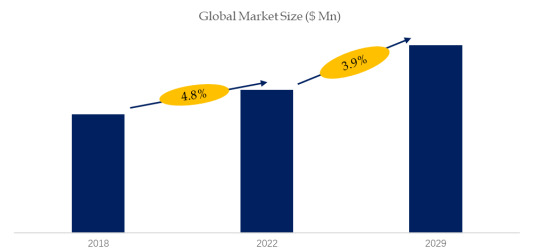
Based on or includes research from QYResearch: Global EMS and ODM (EMS & ODM) Market Report 2023-2029.
Figure. Global EMS and ODM (EMS & ODM) Top 27 Players Ranking and Market Share(Based on data of 2021, Continually updated)
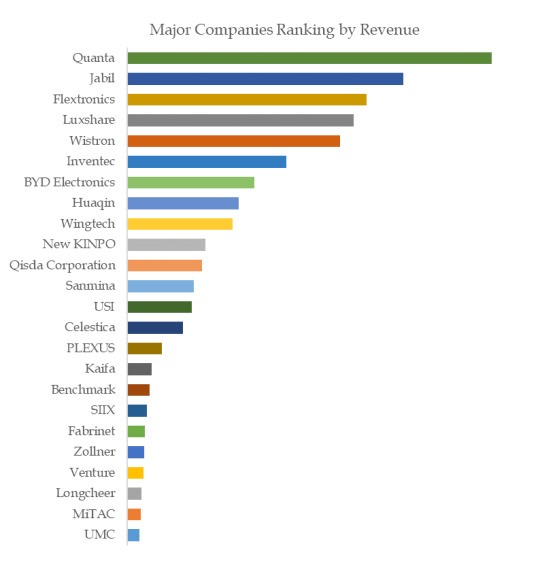
Based on or includes research from QYResearch: 2021 data information of Global EMS and ODM (EMS & ODM) Market Report 2023-2029.
The global key manufacturers of EMS and ODM (EMS & ODM) include HONHAI, Compal, Pegatron, Quanta, Jabil, Flextronics, Luxshare, Wistron, Inventec, BYD Electronics, etc. In 2021, the global top five players had a share approximately 53.0% in terms of revenue.
About QYResearch
QYResearch founded in California, USA in 2007.It is a leading global market research and consulting company. With over 16 years’ experience and professional research team in various cities over the world QY Research focuses on management consulting, database and seminar services, IPO consulting, industry chain research and customized research to help our clients in providing non-linear revenue model and make them successful. We are globally recognized for our expansive portfolio of services, good corporate citizenship, and our strong commitment to sustainability. Up to now, we have cooperated with more than 60,000 clients across five continents. Let’s work closely with you and build a bold and better future.
QYResearch is a world-renowned large-scale consulting company. The industry covers various high-tech industry chain market segments, spanning the semiconductor industry chain (semiconductor equipment and parts, semiconductor materials, ICs, Foundry, packaging and testing, discrete devices, sensors, optoelectronic devices), photovoltaic industry chain (equipment, cells, modules, auxiliary material brackets, inverters, power station terminals), new energy automobile industry chain (batteries and materials, auto parts, batteries, motors, electronic control, automotive semiconductors, etc.), communication industry chain (communication system equipment, terminal equipment, electronic components, RF front-end, optical modules, 4G/5G/6G, broadband, IoT, digital economy, AI), advanced materials industry Chain (metal materials, polymer materials, ceramic materials, nano materials, etc.), machinery manufacturing industry chain (CNC machine tools, construction machinery, electrical machinery, 3C automation, industrial robots, lasers, industrial control, drones), food, beverages and pharmaceuticals, medical equipment, agriculture, etc.
0 notes
Text
Flex
Formerly known as Flextronics, I joined the company to lead the digital rebrand to Flex. Flex is a Fortune 500 product design and contract manufacturing conglomerate with over 200k employees worldwide who support nearly every major brand (Apple, Nike, Google, to name a few) across 12 different verticles from consumer electronics to automotive.
Challenge:
Create a splash announcing the new brand, drive sales leads and conversions, improve the content management system to support faster content creation, and support a user-centric digital experience on a very tight timeline.
Key activities:
Sourced and managed a development agency and content agency, in addition to coordinating activities with a brand design and video agency
Liaised with sales, marketing, and legal stakeholders across each business unit to identify their requirements
Directed, oversaw, and edited each page of content across the website
Results:
7x faster sales lead intake
4x increase in sales lead quality
40% reduction in website bounce rates
2x increase in website page views and sessions
5x increase in content production speed
90% hosting cost reduction

0 notes
Text
Overview of Singapore's Top Manufacturing Industry Players.

Introduction:
Singapore is widely recognized as a global manufacturing hub, with its strategic location, cutting-edge infrastructure, and business-friendly environment attracting some of the world's leading companies. In this blog section, we will provide an overview of Singapore's top manufacturing industry players, shedding light on their contributions to the nation's economy and their respective areas of expertise.
1. Singapore Manufacturing Federation (SMF):
As the national body representing the manufacturing industry in Singapore, the Singapore Manufacturing Federation (SMF) plays a pivotal role in promoting the interests of manufacturers while driving innovation and productivity. With more than 3,000 members comprising both multinational corporations and small-to-medium-sized enterprises, SMF serves as an influential platform for networking, business collaboration, and knowledge exchange.
2. Electronics Manufacturing:
The electronics manufacturing sector is a significant player in Singapore's manufacturer landscape, contributing significantly to the nation's export revenue. Renowned global companies such as Dell, Hewlett Packard Enterprise, and Flextronics have established a strong presence in Singapore, leveraging the country's advanced infrastructure and skilled workforce.
Furthermore, Singapore is also home to several local electronics manufacturing companies that have made their mark. One such prominent player is Venture Corporation Limited, a leading global provider of technology and manufacturing services. Known for its expertise in complex electronic products and life sciences instruments, Venture Corporation has remained at the forefront of the industry.
3. Precision Engineering:
Singapore's precision engineering sector is another pillar of the manufacturing industry in the country. With a focus on producing high-precision components and tools, the precision engineering companies here have gained global recognition for their advanced capabilities. One notable player is UMS Holdings Limited, a manufacturer of high-precision front-end semiconductor components. UMS Holdings has built a reputation for excellence, supplying critical components to major semiconductor equipment makers worldwide.
4. Chemical Industry:
The chemical industry is an essential part of Singapore's manufacturing sector, contributing significantly to the country's GDP. Known for its stringent safety standards and environmentally friendly practices, the chemical industry in Singapore attracts multinational companies seeking a reliable and sustainable manufacturing base. Companies like PL Global, BASF, Evonik, and Shell Chemicals have established a strong presence in Singapore, leveraging the country's extensive infrastructure and favorable investment climate.
In addition to these sectors, Singapore also houses leading players in aerospace manufacturing, pharmaceuticals, food processing, and numerous other industries. The city-state's commitment to research and development, coupled with strong government support, has made it an attractive destination for companies seeking to tap into Asia's dynamic markets.
As Singapore's manufacturing industry continues to excel, embracing innovation, and adapting to global market trends, the nation remains a preferred choice for multinational corporations to establish their regional or even global manufacturing operations. With a mix of international giants and homegrown champions, Singapore's manufacturing landscape presents a diverse and vibrant ecosystem that propels the nation's economic growth and sustainability.
Conclusion:
Singapore's top manufacturing industry players exemplify the country's sophistication, reliability, and commitment to excellence. As they steadily push the boundaries of innovation, these companies contribute immensely to Singapore's economy while cementing the nation's position as a leading global manufacturing hub.
Read more..
0 notes